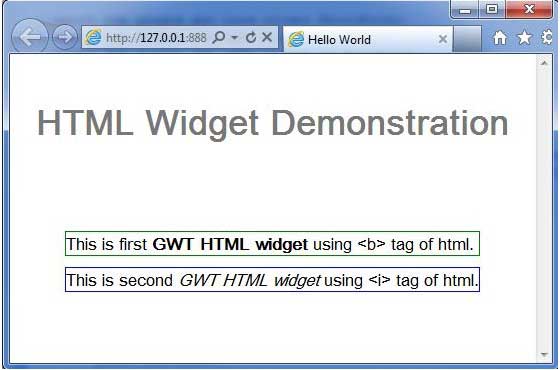
- GWT - Home
- GWT - Overview
- GWT - Environment Setup
- GWT - Applications
- GWT - Create Application
- GWT - Deploy Application
- GWT - Style with CSS
- GWT - Basic Widgets
- GWT - Form Widgets
- GWT - Complex widgets
- GWT - Layout Panels
- GWT - Event Handling
- GWT - Custom Widgets
- GWT - UIBinder
- GWT - RPC Communication
- GWT - JUnit Integration
- GWT - Debugging Application
- GWT - Internationalization
- GWT - History Class
- GWT - Bookmark Support
- GWT - Logging Framework
GWT - HTML Widget
Introduction
The HTML widget can cantain arbitrary HTML it can be interpreted as HTML. This widget uses a <div> element, causing it to be displayed with block layout.
Class Declaration
Following is the declaration for com.google.gwt.user.client.ui.Label class −
public class HTML
extends Label
implements HasHTML
CSS Style Rules
Following default CSS Style rule will be applied to all the HTML widget. You can override it as per your requirements.
.gwt-HTML { }
Class Constructors
| Sr.No. | Constructor & Description |
|---|---|
| 1 |
HTML() Creates an empty HTML. |
| 2 |
protected HTML(Element element) This constructor may be used by subclasses to explicitly use an existing element. |
| 3 |
HTML(java.lang.String html) Creates a HTML with the specified html contents. |
| 4 |
HTML(java.lang.String html, boolean wordWrap) Creates an HTML widget with the specified contents, optionally treating it as HTML, and optionally disabling word wrapping. |
Class Methods
| Sr.No. | Method & Description |
|---|---|
| 1 |
java.lang.String getHTML() Gets this object's contents as HTML. |
| 2 |
void setHTML(java.lang.String html) Sets this object's contents via HTML. |
| 3 |
static HTML wrap(Element element) Creates an HTML widget that wraps an existing <div> or <span> element. |
Methods Inherited
This class inherits methods from the following classes −
com.google.gwt.user.client.ui.Label
com.google.gwt.user.client.ui.UIObject
com.google.gwt.user.client.ui.Widget
com.google.gwt.user.client.ui.HasText
java.lang.Object
Html Widget Example
This example will take you through simple steps to show usage of a HTML Widget in GWT. Follow the following steps to update the GWT application we created in GWT - Create Application chapter −
| Step | Description |
|---|---|
| 1 | Create a project with a name HelloWorld under a package com.tutorialspoint as explained in the GWT - Create Application chapter. |
| 2 | Modify HelloWorld.gwt.xml, HelloWorld.css, HelloWorld.html and HelloWorld.java as explained below. Keep rest of the files unchanged. |
| 3 | Compile and run the application to verify the result of the implemented logic. |
Following is the content of the modified module descriptor src/com.tutorialspoint/HelloWorld.gwt.xml.
<?xml version = "1.0" encoding = "UTF-8"?> <module rename-to = 'helloworld'> <!-- Inherit the core Web Toolkit stuff. --> <inherits name = 'com.google.gwt.user.User'/> <!-- Inherit the default GWT style sheet. --> <inherits name = 'com.google.gwt.user.theme.clean.Clean'/> <!-- Specify the app entry point class. --> <entry-point class = 'com.tutorialspoint.client.HelloWorld'/> <!-- Specify the paths for translatable code --> <source path = 'client'/> <source path = 'shared'/> </module>
Following is the content of the modified Style Sheet file war/HelloWorld.css.
body {
text-align: center;
font-family: verdana, sans-serif;
}
h1 {
font-size: 2em;
font-weight: bold;
color: #777777;
margin: 40px 0px 70px;
text-align: center;
}
.gwt-Green-Border{
border:1px solid green;
}
.gwt-Blue-Border{
border:1px solid blue;
}
Following is the content of the modified HTML host file war/HelloWorld.html.
<html>
<head>
<title>Hello World</title>
<link rel = "stylesheet" href = "HelloWorld.css"/>
<script language = "javascript" src = "helloworld/helloworld.nocache.js">
</script>
</head>
<body>
<h1>HTML Widget Demonstration</h1>
<div id = "gwtContainer"></div>
</body>
</html>
Let us have following content of Java file src/com.tutorialspoint/HelloWorld.java which will demonstrate use of HTML widget.
package com.tutorialspoint.client;
import com.google.gwt.core.client.EntryPoint;
import com.google.gwt.user.client.ui.HTML;
import com.google.gwt.user.client.ui.RootPanel;
import com.google.gwt.user.client.ui.VerticalPanel;
public class HelloWorld implements EntryPoint {
public void onModuleLoad() {
// create two HTML widgets
HTML html1 =
new HTML("This is first GWT HTML widget using <b> tag of html.");
HTML html2 =
new HTML("This is second GWT HTML widget using <i> tag of html.");
// use UIObject methods to set HTML widget properties.
html1.addStyleName("gwt-Green-Border");
html2.addStyleName("gwt-Blue-Border");
// add widgets to the root panel.
VerticalPanel panel = new VerticalPanel();
panel.setSpacing(10);
panel.add(html1);
panel.add(html2);
RootPanel.get("gwtContainer").add(panel);
}
}
Once you are ready with all the changes done, let us compile and run the application in development mode as we did in GWT - Create Application chapter. If everything is fine with your application, this will produce following result −
